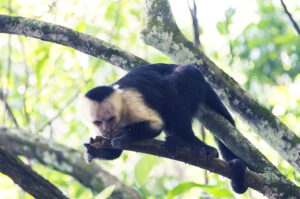Kaj Halberg - writer & photographer
Travels ‐ Landscapes ‐ Wildlife ‐ People
Costa Rica 2012: Coastal hike to Corcovado
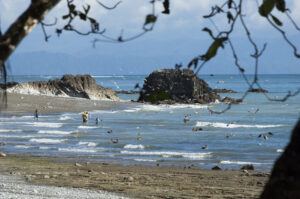
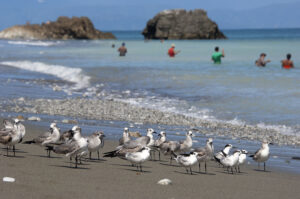
In the small town of Puerto Jiménez, my companion Lars Skipper and I book a room in a simple hotel, whereupon we seek out the national park office to get permits to enter the park. As it turns out, this is a rather complicated task. The entry fee must be paid in a particular bank, or at a local travel agency, before the permit can be issued.
As it is a Saturday, the bank is closed, so we go to a travel agency. The owner informs us that he has to send an e-mail to the bank, as well as to the park office, to confirm that he has received our payment. An answer may take some time, so he instructs us to return around 6 p.m. to collect our permits.

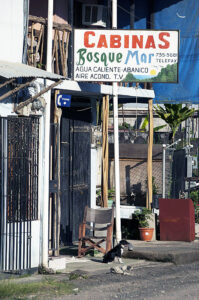
In the morning sun, various passerines are perched on electric wires, including variable seedeater (Sporophila corvina), grey-breasted martin (Progne chalybea), and a beautiful male scarlet-rumped tanager (Ramphocelus passerinii), displaying its scarlet rump. We also observe plain-breasted ground dove (Columbina minuta) and Costa Rican house wren (Troglodytes aedon ssp. inquietus).
The ubiquitous black vultures (Coragyps atratus) are not exactly beautiful creatures, having ugly, naked heads full of wrinkles.
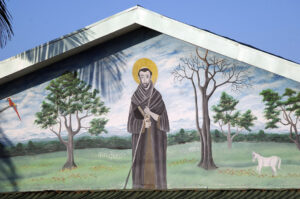
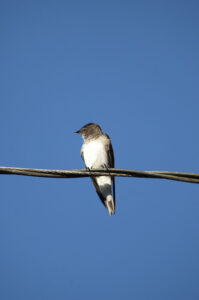

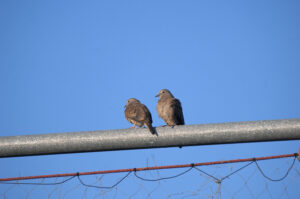
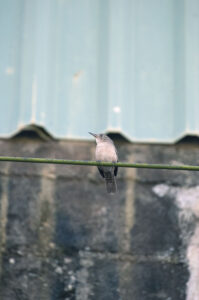
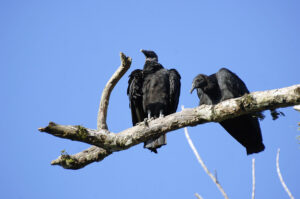
Young animals are able to run along the surface of the water at a terrific speed, its legs moving so fast that they resemble a whisk. For this reason, the species is sometimes called Jesus Christ lizard, although that name is usually reserved for the common basilisk (B. basilicus).
In the forest above the mangrove, we observe black spiny-tailed iguana (Ctenosaura similis), which somewhat resembles the Old-World monitor lizards. This large lizard is widespread in Mexico and Central America. The male is grey with black vertical stripes on the body, and it has a large crest along the back. The female is brownish without stripes, and the crest is very small.
Gasteracantha cancriformis is a spiny-backed orb-weaver, a genus of at least 60 species of spiders, which are distributed worldwide in warmer areas. The generic name is derived from the Greek gaster (‘belly’) and acantha (‘thorn’), referring to a number of spines, usually 6, protruding from the abdomen. These spines, as well as a shield-like carapace, covering almost the entire animal, are means of defense against enemies.
Among a wealth of plants, we notice a reddish species of Tillandsia, of the pineapple family (Bromeliaceae), which grows as an epiphyte on a horizontal branch, and red ginger (Alpinia purpurata), whose bracts are bright red, whereas the small flowers are white. This species is native to Indonesia, New Guinea, and Polynesia, but has been introduced as an ornamental to most warm countries of the world.
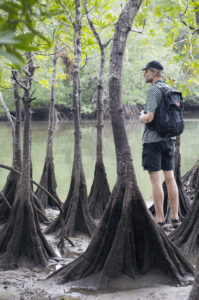
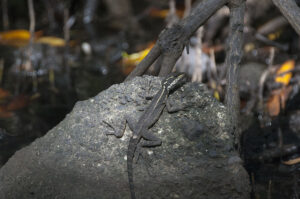
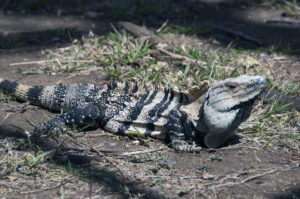
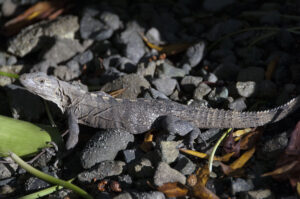
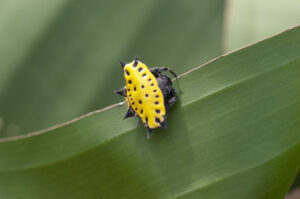
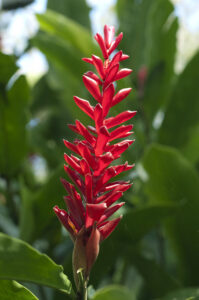
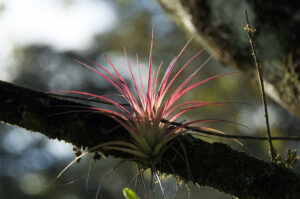
In their nest, they have ‘gardens’ where they grow a fungus of the family Lepiotaceae. The fresh vegetation is used as nutrition for this fungus, and the ants remove mold and parasites from the fungus. Bacteria growing on the ants secrete chemicals, which act as pesticides. The ants are able to detect if a particular type of leaf is toxic to the fungus, and in that case they will no longer collect it.
The fungus is used as food for the ant larvae, whereas adult ants feed on leaf sap. The larvae need the fungus to stay alive, and the fungus needs the ants to stay alive – a perfect example of symbiosis.
The nest, which can be as deep as 7 m, is placed in a way that allows a breeze to remove dangerous carbon dioxide emitted by the fungus. (Source: en.wikipedia.org/wiki/Leafcutter_ant, where a list of references is given)
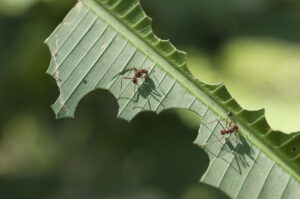
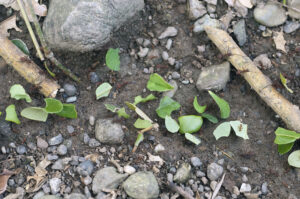
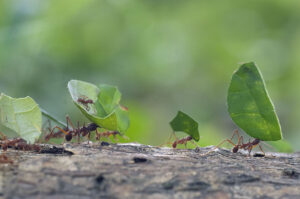
We encounter two species of caracaras, which belong to the falcon family (Falconidae), but, as opposed to true falcons, they often walk about on the ground. A yellow-headed caracara (Milvago chimachima) is strolling down the road in front of our car. This bird is resident from Costa Rica southwards to northern Argentina, Paraguay, and Uruguay, living in savanna, swamps and forest edges, and also often scavenging in cities.
At the roadside, a crested caracara (Caracara plancus) is collecting nesting material. This species is found in a huge area, from southern Arizona, Texas, Florida, and Cuba southwards through Mexico and Central America to Tierra del Fuego and the Falkland Islands. It is divided into two subspecies, cheriway, which is found southwards to Peru and northern Brazil, and plancus further south.
A beautiful Amazon kingfisher (Chloroceryle amazona) is perched on a dead tree, and in a dense patch of grass we observe a male blue seedeater (Amaurospiza concolor), jumping vertically into the air, landing on the same spot – presumably part of its courtship display.
The smooth-billed ani (Crotophaga ani), a black member of the cuckoo family (Cuculidae), is widely distributed, in southern Florida, the Caribbean, Central America, and the major part of South America.
A golden-crowned spadebill (Platyrinchus coronatus) is perched on an aerial root of a large fig tree, a peculiar bird with a flat bill, which belongs to the tyrant-flycatcher family (Tyrannidae).
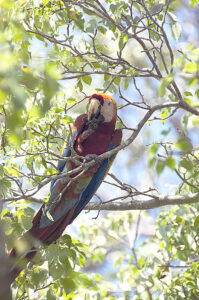
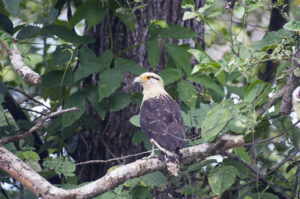
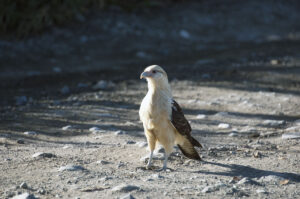
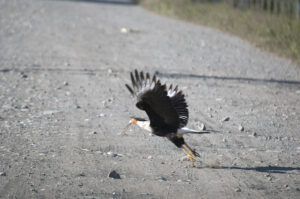

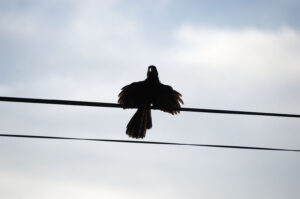
On the day of our hike, low tide is around noon, which means that we must start our hike from the village of Karate around 6 a.m. We shall have to get up at 3 o’clock, as the drive along the horrible road to Karate will last at least two hours – a fact which we found out by personal experience the previous day.
As it turns out, our morning drive is a marvellous experience. The Full Moon sets behind a plantation of palm trees, while a blanket of fog is covering a field with grazing cattle.
It is daylight, when we arrive at Karate. We have learned that we can park our car at a pulperia – a small grocery store, selling daily supplies and soft drinks. The owner gets grumpy, when we park our car in front of his ’fancy’ store. We must park behind it!
How did he expect us to know?
He soon calms down, however, and we can commence our hike along the beach.
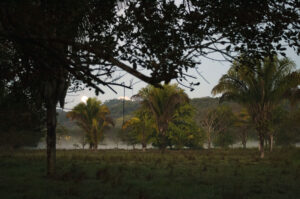
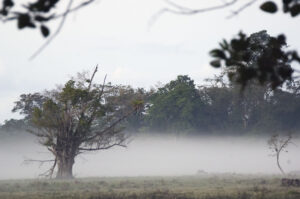
The beach is alive with hermit crabs of all sizes, crawling about with their soft bodies hidden inside protective snail shells, which come in all sorts of shapes – round, oblong, spiraled. Judging from their tracks, which create fine patterns in the sand, they seem to prefer feeding around pebbles.
Long lines of brown pelicans (Pelecanus occidentalis) glide effortlessly along the coast. Occasionally, several birds plunge headlong into the water from a great height, indicating a school of fish.
A common black-hawk (Buteogallus anthracinus) is perched in a palm tree. This raptor is mainly feeding on crabs, and we observe another one walking about among the low coastal rocks. A bare-throated tiger-heron (Tigrisoma mexicanum) seems petrified, looking for fish in a rock-pool.
For a long time, a white-nosed coati (Nasua narica) walks on the beach in front of us. Like its close relatives, the raccoons, this animal is omnivorous, often feeding along the coast. It is described in depth on the page Animals – Mammals: Long-nosed coatis – charming bandits.
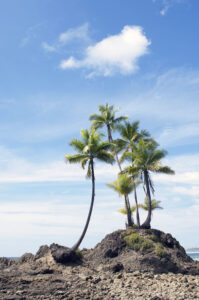
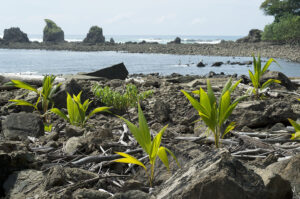
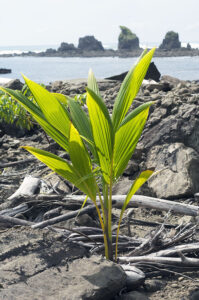
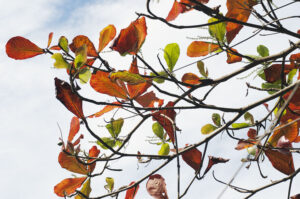

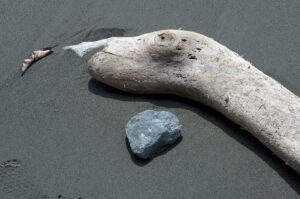
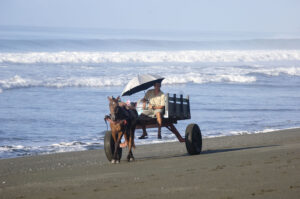

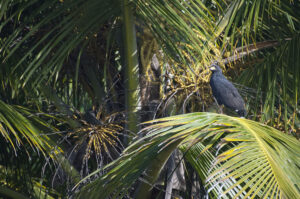
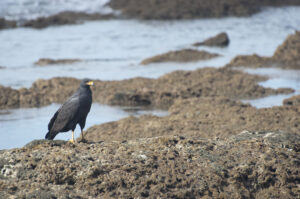
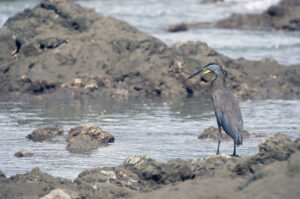
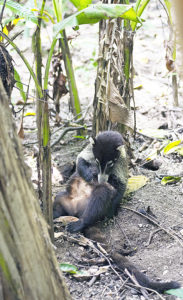
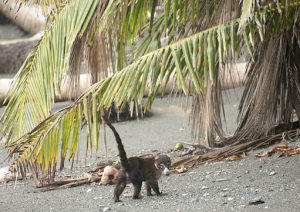
Herbs include two colourful species with orange-red flowers, Kohleria spicata, which belongs to the family Gesneriaceae, and Odontonema tubaeforme, of the family Acanthaceae.
We have the great luck to be able to join company with a tourist group, who have hired a local guide. He has eyes like a hawk, pointing out various animals, which we might otherwise have missed.
A northern tamandua (Tamandua mexicana) is sprawled along a branch, sleeping comfortably, whereas another is busy fouraging in a tree. This small anteater is distributed from southern Mexico southwards to western Venezuela, Columbia, and Ecuador.
We often observe coatis and small, brown squirrels, and elegant Central American spider monkeys (Ateles geoffroyi) swing from one branch to another in a superior style. This species is presented on the page Animals – Mammals: Monkeys and apes.
Birdlife is surprisingly scarce in the forest. We only observe chestnut-backed antbird (Myrmeciza exsul), red-crowned woodpecker (Melanerpes rubricapillus), and a species of woodcreeper of the family Dendrocolaptidae.
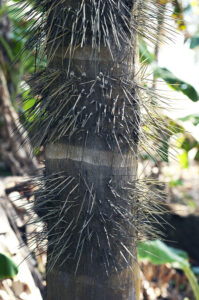
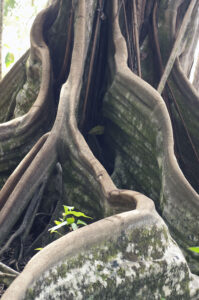
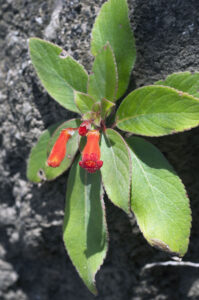
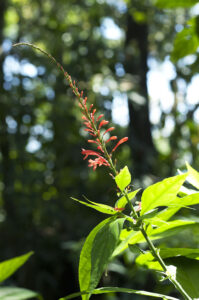
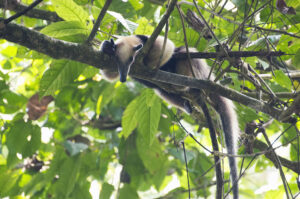

When we finally arrive at Sirena, we are rather exhausted, so we enjoy a well-deserved rest before commencing an evening stroll to the coast. Several nightjars are feeding over the tiny airstrip, and a chorus of golden-mantled howler monkeys (Alouatta palliata ssp. palliata) can be heard from the forest, far away. Sunset over the Pacific Ocean is magnificent.
We retire early, as we intend to get up around 5 a.m. to experience morning life in the rainforest. At dawn, the howler monkeys are making a racket, and we observe several forest birds, including a great curassow (Crax rubra) and two great tinamous (Tinamus major). Tinamous resemble game birds, but constitute an ancient order of their own, Tinamiformes. On our way back towards the lodge, we are lucky to spot an ocelot (Leopardus pardalis), crossing the runway about 200 m away.
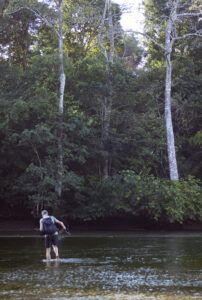
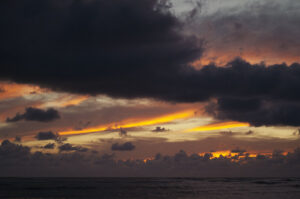
On our return trip, we again observe a tamandua and spider monkeys, and also a troupe of feeding Central American white-faced capuchin monkeys (Cebus imitator), searching for edibles by biting off bark of lianas and branches. This species is native to forests of Honduras, Nicaragua, Costa Rica, and western Panama. It is quite common in Costa Rica, living in a varity of forest types, and it is often confiding.
In the West, it is one of the best known of all monkeys, as it was often the faithful companion of the organ grinder, who would walk from town to town, playing his organ, while his monkey would perform a dance.
Until recently, this animal was considered conspecific with the Columbian white-headed capuchin (C. capucinus), which is found in coastal areas from eastern Panama southwards to Ecuador.
The word capuchin derives from a group of Franciscan friars, named the Order of Friars Minor Capuchin, which arose in 1520, when Italian friar Matteo da Bascio claimed that God had informed him that the manner of life led by his contemporary friars was not the one, which St. Francis of Assisi had dictated. The friars of this order wear brown robes with pointed hoods, called capuche. When the conquistadors reached Central America late in the 15th Century, they noticed some small monkeys, whose colouring resembled these friars, so they named them capuchins. (Source: en.wikipedia.org/wiki/Capuchin_monkey)
We are indeed tired, when we arrive at Karate, but have yet to face a car ride of at least two hours back to Puerto Jiménez. At our hotel, we have a much-needed shower, before we go out to eat – and then right back to the hotel to get some much-needed sleep.

